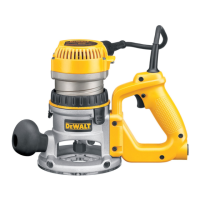ENGLISH
10
Repairs
WARNING: To assure product SAFETY and RELIABILITY,
repairs, maintenance and adjustment (including power
cord repairs, and brush inspection and replacement,
when applicable) should be performed by a DeWALT
factory service center or a DeWALT authorized service
center. Always use identical replacementparts.
Accessories
WARNING: Since accessories, other than those offered
by DeWALT, have not been tested with this product, use
of such accessories with this tool could be hazardous.
To reduce the risk of injury, only DeWALT recommended
accessories should be used with thisproduct.
Recommended accessories for use with your tool are available
at extra cost from your local dealer or authorized service
center. If you need assistance in locating any accessory, please
contact DeWALT call 1‑800‑4‑DeWALT (1-800-433-9258) or
visit our website: www.dewalt.com.
Keep the 1/2" (13mm) collet and nut
22
and the 1/4"
(6.4mm) insertable collet
21
clean before and after use to
avoidcontamination.
Cleaning
WARNING: Blow dirt and dust out of all air vents with
clean, dry air at least once a week. To minimize the risk
of eye injury, always wear ANSI Z87.1approved eye
protection when performingthisprocedure.
WARNING: Never use solvents or other harsh
chemicals for cleaning the non‑metallic parts of the
tool. These chemicals may weaken the plastic materials
used in these parts. Use a cloth dampened only with
water and mild soap. Never let any liquid get inside the
tool; never immerse any part of the tool into aliquid.
MAINTENANCE
WARNING: To reduce the risk of serious personal
injury, turn unit off and disconnect it from
power source before making any adjustments or
removing/installing attachments or accessories.
An accidental start‑up can causeinjury.
Adjusting the Plunge Routing Depth
(Fig. I)
1. Unlock the plunge mechanism by pushing up the plunge
lock lever
17
. Plunge the router down as far as it will go,
allowing the bit to just touch theworkpiece.
2. Lock the plunge mechanism by pushing the plunge lock
lever
17
down.
3. Loosen the depth adjustment rod
16
by turning the
wingscrew
29
counterclockwise.
4. Slide the depth adjustment rod
16
down so that it
meets the lowest turret stop
15
.
5. Slide the tab
30
on the depth adjustment rod down so
that the top of it meets zero on the pillar scale
31
.
6. Grasping the top, knurled section of the depth
adjustment rod
16
, slide it up so that the tab
30
aligns
with the desired depth of cut on the pillar scale
31
.
7. Tighten the wingscrew
29
to hold the depth adjustment
rod inplace.
8. Keeping both hands on the handles, unlock the plunge
mechanism by pushing the plunge lock lever
17
up. The
plunge mechanism and the motor will move up. When
the router is plunged, the depth adjustment rod will hit
the turret stop, allowing the router to reach exactly the
desireddepth.
Fine Adjustment of Routing Depth (Fig. I)
The knurled knob
32
at the bottom end of the depth
adjustment rod can be used to make minoradjustments.
1. To decrease the cutting depth, rotate the knob clockwise
(looking down from the top of therouter).
2. To increase the cutting depth, rotate the knob
counterclockwise (looking down from the top of
therouter).
NOTE: One complete rotation of the knob results in a change
of about 5/128" or .04" (1 mm) indepth.
Using the Rotating Turret Stop (Fig. J)
WARNING: Do not change the turret stop while the
router is running. This will place your hands too near
the cutterhead.
The turret depth stop can be used to set 5different depths.
One of the turret stops is adjustable. To use the adjustable
turret stop, loosen the nut
33
, then adjust the screw
34
to
the desired height. Turning the screw counterclockwise will
raise the screw which will decrease the cutting depth. The
turret stop is useful for making deep cuts in severalpasses.
Dust Extraction (Fig. A, K)
To connect the router to a vacuum cleaner for dust
extraction, follow these steps:
1. Remove the dust cap
19
by pulling straightup.
2. Insert the dust extraction hose adapter
35
into the dust
extraction port
36
asshown.
3. Insert the end of a standard vacuum cleaner tube
37
into the hoseadapter.
4. When using dust extraction, be aware of the placement
of the vacuum cleaner. Be sure that the vacuum cleaner is
stable and that its hose will not interfere with thework.
Operation: Plunge Base
Gripping Locations (Fig. A)
Grip both knob
5
handles whileoperating.
Cutting with the Plunge Base (Fig. I)
CAUTION: Turn the router on before plunging the
cutter head into theworkpiece.
1. Unlock the plunge lock lever
17
.
2. Plunge the router down until the bit reaches the
setdepth.
3. Lock the plunge lock lever
17
.
4. Perform thecut.
5. Unlock the plunge lock lever. This will allow the router bit
to disengage thework.
6. Turn the routeroff.

